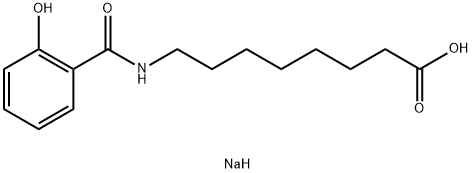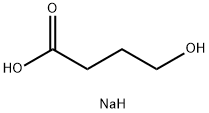Salcaprozate Sodium
- CAS NO.:203787-91-1
- Empirical Formula: C15H22NNaO4
- Molecular Weight: 303.33
- MDL number: MFCD00952954
- EINECS: 231-019-4
- SAFETY DATA SHEET (SDS)
- Update Date: 2025-12-26 08:49:36

What is Salcaprozate Sodium?
Description
Salcaprozate sodium (SNAC) is the sodium salt form of salcaprozate, an oral absorption promoter. Salcaprozate sodium may be used as a delivery agent to promote the oral absorption of certain macromolecules with poor bioavailability such as insulin and heparin.It is also used as an excipient in drug formulation as a chemical permeation enhancer (PE) to aid the oral absorption of macromolecules, peptides and proteins such as insulin (diabetes), heparin (heart attacks and angina) and cyanocobalamin (vitamin B12 deficiency and anaemia) which would otherwise have poor bioavailability. SNAC is considered to be safe for human consumption (GRAS) by the FDA.
Chemical properties
It is a white to off-white crystalline powder, and its solubility in water is approximately 33 mg/mL.
The Uses of Salcaprozate Sodium
Salcaprozate Sodium is a drug excipient or inactive ingredient in drug formulations.
Definition
Salcaprozate Sodium (SNAC) is a synthetic N-acetylated amino-acid derivative of salicylic acid. SNAC is a weak acid that display amphiphilicity and surface activity. It was discovered as part of a screen to identify carrier-based PEs that could “chaperone” poorly permeable payloads across the intestine. This compound is the most extensively tested carrier and the only PE approved in an oral formulation designed to improve oral BA, albeit with a small molecule, cyanocobalamin/SNAC. In other preclinical studies, it also improved intestinal permeation of peptides (salmon calcitonin (sCT) and insulin), along with poorly permeable small molecules (e.g., cromolyn). SNAC was tested in many formats: taste-masked liquids, tablets, and soft gelatin capsules. Similar to C10, SNAC can be blended with the active pharmaceutical ingredient (API) using conventional processes, which makes manufacturing uncoated oral tablet dosage forms economic and relatively easy to scale[1].
Side Effects
Animal studies of Salcaprozate Sodium (SNAC) showed an associated mortality rate that was only evident at the 2000 mg/kg/day level, 20 per cent in males and 50 per cent in females; there was no clear cause of death. In the Wistar rat study, no mortality was observed at doses up to 1000 mg/kg/d. Clinicopathological parameters included slightly altered electrolyte levels and decreased globulin levels, and slightly higher liver and kidney weights, but no corresponding histopathological changes.Adverse effects of SNAC in Wistar rats were evident at levels up to 1000 mg/kg/d. The results of this study are summarised in the table below.
in vitro
SNAC (12.5-400 μg/mL; 24 h) has no toxicity to Caco-2 cells, and the survival percentage is above 90% when SNAC is 200 μg/mL.
SNAC (50 and 200 μg/mL) improves the apparent permeability coeffcient (Papp) of RA and SA-B by 2.14-fold and 3.68-fold compared with the Papp of SAs solution.
in vivo
SNAC improves the oral absorption of both R1 and SAs and enhances bioavailability in rats.
SNAC (2000 mg/kg/d; oral gavage for 13 weeks) related mortality is evident only at the 2000-mg/kg/d level, 20% among males and 50% among females; no clear cause of death is evident.
SNAC (100-1000 mg/kg/d; oral gavage for 13 weeks) induces no mortality in the Wistar rat study at doses up to 1000 mg/kg/d
Mode of action
The mode of action of Salcaprozate Sodium is controversial, and many scientists have explored its mechanism from various angles. Theory of oral semaglutide absorption, as advocated by Novo Nordisk. The optimum once-daily tablet consists of 14 mg of semaglutide co-formulated with 300 mg of SNAC. After digestion, the tablet erodes rapidly in the stomach, resulting in the release of a highly concentrated amount of SNAC that neutralizes the pH of gastric fluid in the immediate vicinity of the tablet to inactivate pepsin. SNAC is thought to induce semaglutide monomer production and increase gastric epithelial membrane fluidity, but without affecting tight junctions, thereby allowing transcellular passage of semaglutide into systemic circulation. Part of the role of SNAC seemed to be to convert semaglutide to a more permeable monomeric form and it seems to perform this better when formulated in a stomach-specific tablet[1].SNAC forms a conjugate base at the pH of the small intestinal lumen, so it can undergo complexation via hydrophobic ion pairing (HIP) with the conjugate acid of basic amino-acid side chains in macromolecules. However, HIP cannot fully account for Eligen-mediated hydrophobization of anionic payloads including heparin and cromolyn.
References
[1] Twarog C, et al. Intestinal Permeation Enhancers for Oral Delivery of Macromolecules: A Comparison between Salcaprozate Sodium (SNAC) and Sodium Caprate (C10). Pharmaceutics, 2019; 11: 78.
[2] SARINJ FATTAH . Salcaprozate sodium (SNAC) enhances permeability of octreotide across isolated rat and human intestinal epithelial mucosae in Ussing chambers[J]. European Journal of Pharmaceutical Sciences, 2020, 154: Article 105509. DOI:10.1016/j.ejps.2020.105509.
[3] M GARY I RILEY Ellen A P M Cristina Castelli. Subchronic oral toxicity of salcaprozate sodium (SNAC) in Sprague-Dawley and Wistar rats.[J]. International Journal of Toxicology, 2009, 28 4: 278-293. DOI:10.1177/1091581809337737.
Properties of Salcaprozate Sodium
| Melting point: | 183 - 185°C |
| storage temp. | Inert atmosphere,Room Temperature |
| solubility | DMSO (Slightly), Methanol (Slightly) |
| form | Solid |
| color | White to Off-White |
| Stability: | Hygroscopic |
Safety information for Salcaprozate Sodium
| Signal word | Warning |
| Pictogram(s) |
 Exclamation Mark Irritant GHS07 |
| GHS Hazard Statements |
H302:Acute toxicity,oral H315:Skin corrosion/irritation H319:Serious eye damage/eye irritation H335:Specific target organ toxicity, single exposure;Respiratory tract irritation |
| Precautionary Statement Codes |
P261:Avoid breathing dust/fume/gas/mist/vapours/spray. P305+P351+P338:IF IN EYES: Rinse cautiously with water for several minutes. Remove contact lenses, if present and easy to do. Continuerinsing. |
Computed Descriptors for Salcaprozate Sodium
Salcaprozate Sodium manufacturer
New Products
4,4-Difluoropiperidine hydrochloride tert-butyl 9-methoxy-3-azaspiro[5.5]undecane-3-carboxylate Indole Methyl Resin N-Isopropylurea N,N-Dicyclohexylcarbodiimide(DCC) MELDRUMS ACID 5-METHYLISOXAZOLE-4-CARBOXYLIC ACID Magnessium Bis glycinate Zinc ascorbate 1-bromo-2-butyne 2-acetamidophenol 9(10H)-anthracenone Erythrosin B, 4-Piperidinopiperidine 2-((4-morpholinophenylamino) (methylthio) methylene) malononitrile 2,4-dihydroxybenzaldehyde 3-(4-morpholinophenylamino)-5-amino-1H-pyrazole-4-carbonitrile Methyl 2-methylquinoline-6-carboxylate 2,6-dichloro-4-nitropyridine 4-Bromo-2-chlorobenzonitrile 2-(benzylamino)acetic acid hydrochloride 4-(tert-Butoxycarbonylamino)but- 2-ynoic acid 3,4-dihydro-2H-benzo[b][1,4]dioxepine 1-Phenyl-1-cycloprppanecarboxylicacidRelated products of tetrahydrofuran
You may like
-
 203787-91-1 Salcaprozate Sodium 99%View Details
203787-91-1 Salcaprozate Sodium 99%View Details
203787-91-1 -
 203787-91-1 98%View Details
203787-91-1 98%View Details
203787-91-1 -
 203787-91-1 >98%View Details
203787-91-1 >98%View Details
203787-91-1 -
 203787-61-1 >98%View Details
203787-61-1 >98%View Details
203787-61-1 -
 Octanoic acid CAS 203787-91-1View Details
Octanoic acid CAS 203787-91-1View Details
203787-91-1 -
 203787-91-1 98%View Details
203787-91-1 98%View Details
203787-91-1 -
 Salcaprozate Sodium API, IPView Details
Salcaprozate Sodium API, IPView Details
203787-91-1 -
 20677-73-0 (2,2-diethoxyethyl)methylamine 98%View Details
20677-73-0 (2,2-diethoxyethyl)methylamine 98%View Details
20677-73-0


